Learn how to dance the tarantella
Global Moves: Learn the Tarantella of Italy w/ Alessandra Belloni
See Dates
$20 per device
1 hour
$20 per person
See Dates
What We’ll Do
There are many ways to experience a new culture. You can try the food, read the literature, or listen to the music, just to name a few. But in this new digital series, we want you to get out of your seat and explore the world through movement and dance!
During this monthly, one-hour live experience, guests of all ages are invited to discover the roots of cultural dances from around the globe, learning some steps and uncovering the meaning behind the moves. This month, we’ll be joined by Alessandra Belloni who will be introducing us to the tarantella of Italy. To start, Alessandra will explore the evolution of the tarantella from pre-Christian times to the dance we know today. You’ll learn about the Myth of Aracne and the origins of the tarantella as a form of music and dance therapy that originated in Puglia. Known as pizzica tarantata, the traditional ancient healing trance dance of the tarantella was used for centuries throughout the Mediterranean to cure the mythical bite of the tarantula.
After the presentation, it’s time to dance! Alessandra will pick up her tambourine to accompany dancer Francesca Silvano as you learn the steps of the pizzicarella - an energetic social dance usually performed in a circle. Francesca will also demonstrate the women's work chant ritual, fimmene fimmmene, and the pizzica tarantata - the Spider Dance, a powerful and dynamic ritual dance. For the dance, you are encouraged to be barefoot or in comfortable shoes and to wear white and red, the traditional ceremonial colors of the ancient tarantella.
Where We’ll Be
Zoom!
Share this event with someone who would love it.
Copy Link
About Your Host
Alessandra Belloni
What Else You Should Know
Once registered, you can access the Zoom room for this experience through your confirmation email or Eventbrite account. Atlas Obscura online experiences are recommended for attendees age 13+.
Atlas Obscura online experiences are recommended for attendees age 13+.
This Online Experience will be recorded. A temporary link to the recording will be provided in a follow-up email to all ticket holders within 72 hours after the event. Access to this recording will be available for seven days.
We provide closed captioning for all of our Online Experiences, as well as transcripts upon request. Please reach out to us at [email protected] if you have any questions, requests, or access needs.
This event is one of Atlas Obscura’s Online Experiences. At Atlas Obscura, our mission has always been to inspire wonder and curiosity about the incredible world we all share. Now, more than ever, there’s a need to stay connected—not only to our sense of wonder, but to each other.
We encourage you to follow and share the hashtag #AOExperiences for more incredible online experiences and our newest addition of Online Courses with Atlas Obscura and our friends. And check out AtlasObscura. com, the definitive guide to the world’s hidden wonders, to keep virtually exploring the world through the website’s atlas of amazing places, unique stories, and videos.
com, the definitive guide to the world’s hidden wonders, to keep virtually exploring the world through the website’s atlas of amazing places, unique stories, and videos.
Dates and Availability
| | ||||||||||||||||||||||||||||||||
| ||||||||||||||||||||||||||||||||
| Resources Art, Cuisine, Famous Italians, Festivals, Folklore, Genealogy, Holidays, Hotels, Photos, Real Estate, Sports, Travel and More Guides Surname Collection Add your name to the collection.  Recipes Authentic Italian recipes for you to enjoy. Photo Galleries Enjoy photos of Italy, wine making & more. Proverbi Proverbs in Italian & English. Our Paesani Weekly column dedicated to today's Italy. by Francesca Di Meglio Italian Memories Articles on growing up Italian. by Cookie Curci Una Mamma Italiana Articles for Italian mammas. by Tiffany Longo Learn Italian English-Italian guides Spanish-Italian guides. Molto Italiano Sign up for our FREE newsletter. Trivia Test your knowledge of Italy. | Naples (Campania)
Return to Folk Dances Page
|
Buy Now American Grown Partner Links Shops/Stores Italiansrus Gear Proudly display the colors of Italy with these great products.  The world largest online retailer for Premium Italian Fashions. Travel Booking.com | ||||||||||||||||||||||||||||||
Dance tarantella (tarantella) - the musical symbol of Italy
Tarantella (tarantella) - the most famous Italian dance, which has become a real symbol of the country and the Italian nation.
This bright and lively dance is shrouded in centuries-old legends and myths, one way or another connected with poisonous tarantula spiders. The legend says that in the 14th-15th centuries in the southern regions of Italy near the city of Taranto, tarantulas bred and bit women. Of course, only commoners who worked in the field were bitten. Under the influence of the poison of tarantulas, poor women fell ill with tarantism (tarantism is a medical term for one of the forms of hysterical behavior). There was talk of a real epidemic. A method of treating those who fell into a trance with the help of dance was proposed. Musicians surrounded the woman and played music at a fast pace, forcing the patient to dance. Sometimes this dance was called the spider dance.
Musicians surrounded the woman and played music at a fast pace, forcing the patient to dance. Sometimes this dance was called the spider dance.
One of the older legends says that the tarantella originated in the time of sacrifices, when a beauty sacrificed to spiders, making quick movements, tried to avoid bites.
There is also a version that in the old days, the consequences of a tarantula bite, of which there are plenty in southern Italy today, were eliminated with the help of profuse sweating. Dance until the seventh sweat and was tarantella. Wandering musicians were always ready to come to the aid of a bitten spider. Everyone who happened to be nearby hurried to help. So the dance became pair and group. Later, the tarantella was considered the personification of lust, because frantically dancing women have always attracted increased male attention.
The noble gentlemen also liked the Tarantella. In the 17th century, the tarantella began to be danced even at balls. By that time, the epidemic of tarantism had also ceased.
By that time, the epidemic of tarantism had also ceased.
Tarantella music is always improvisation with great sound extensions and cadence additions. They perform tarantella on various musical instruments - mandolin, accordion, guitar, but always without fail to the accompaniment of tambourine and castanets.
Tarantella has become a classic. This dance can be seen in the theater and cinema, it has penetrated into literature and painting. We can safely say that the tarantella is part of the soul of a true Italian. Today the tarantella is ubiquitous in Italy, but is still more popular in the southern regions. No holiday is complete without this incendiary dance. In different regions of Italy, the tarantella has its own characteristics, and sometimes a special name. Tarantellas differ in different regions and in the degree of fury of the dance, in some places it can even look somewhat sedate.
No Italian carnival is complete without a tarantella!
Neapolitan Tarantella:
Neapolitan Tarantella on accordion:
Neapolitan Tarantella performed by the orchestra. Vocal by Renzo Arbore:
Neapolitan tarantella performed by Mario Lanza:
Neapolitan tarantella Pulcinella:
Tarantella of the Apulia region:
30002 Tarantella Sicilian:
Tarantella Kalabria region:
And this is for those who want to learn how to dance to tarantella:
updated: Victoria camilleri Tags: holidays
Tutan or illness? Words expressed by this card
Double card. On the one hand, he advises you to be patient and finish what you started, on the other hand, you run the risk of being caught in a web.
Card symbols:
The spider is an ancient symbol of creation, creativity and diligence. The ancient Indian tradition allegorically calls Brahma - the creator of all things - a spider that weaves the world from the web-matter. On the one hand, the spider acts as a protector of people, a wonderful savior, a guardian of the hearth.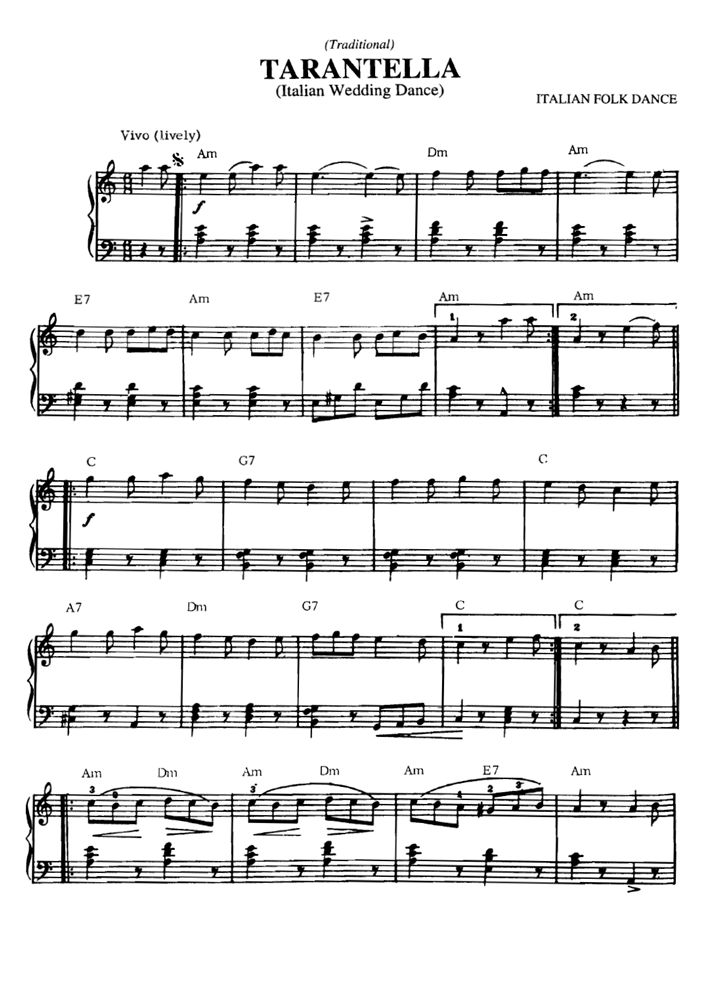 However, it is associated with cruelty, greed, deceit. The positive meaning of this creature was reflected in the myths about spiders, which taught people the craft, the art of weaving. According to legend, the spider saved David, Jesus Christ, the prophet Muhammad from ill-wishers. There is a widespread motif of the transformation of a spider's web into a saving thread that leads the hero out of a dangerous place or helps him climb into the sky, and then safely descend. The negative meaning of the spider refers to the image of a sorcerer spider, a werewolf. The spider was widely used in black and white magic. Amulets and amulets with spider symbols kept the owner from the dark forces interfering in his life.
However, it is associated with cruelty, greed, deceit. The positive meaning of this creature was reflected in the myths about spiders, which taught people the craft, the art of weaving. According to legend, the spider saved David, Jesus Christ, the prophet Muhammad from ill-wishers. There is a widespread motif of the transformation of a spider's web into a saving thread that leads the hero out of a dangerous place or helps him climb into the sky, and then safely descend. The negative meaning of the spider refers to the image of a sorcerer spider, a werewolf. The spider was widely used in black and white magic. Amulets and amulets with spider symbols kept the owner from the dark forces interfering in his life.
The spinner Arachne challenged the goddess Athena herself to a duel, who recognized the skill of her rival, but destroyed her creation. Arachne committed suicide, but the goddess turned her into a spider. In this Greek myth, the motif of the werewolf of a man into a spider, characteristic of many cultures, can be traced.
Dance of the tarantula
According to legend, in the Middle Ages, a terrible disaster struck the Italian city of Taranto - tarantulas, or wolf spiders, simply exterminated the townspeople and residents of the city's environs. It was believed that the bite of this spider causes a terrible disease - tarantism, which quickly leads to insanity. You can be cured of madness only by dancing a swift fast dance - a tarantella. Soon this dance became an integral part of weddings in southern Italy.
Card value:
The spider spins a thread, a thread of fate, he always finishes his work if someone does not interfere with him. A card that shows that what happens in your life is what should happen, what is supposed to be by fate. The spider is slow, he knows what he is doing, the spider always completes his work if someone does not interfere with him. The card advises you to finish what you started, to complete the process, regardless of whether you like it or not.
The spider is not chasing anyone, the spider spins a web and waits for the victim. Patiently, calmly. He is sure that his food will arrive, and since he did the job well, he will definitely fall into his network and will not be able to escape.
Beware of deception, traps, look at nearby cards - maybe you are not a spider, but its victim? Maybe you don't have to sit quietly and patiently while the spider finishes spinning its web to close your exits?
In order to see the web - you need light, the advice of someone who can shed light on the situation. Who would you contact? Think, now you are playing with fate. Any sudden movement can either break the web and set you free, or entangle you, depriving you of the possibility of movement and maneuver.
The words expressed by this card:
financial luck, everything is going as it should be, advice is needed, stop and listen to advice, do not make sudden movements, thoroughness in business, mistakes must be excluded, calmness and self-control, expectant position, thoughtfulness, logic, multi-way combination, deceit, lies, closed roads with the wrong decision.
The origin of this incendiary dance is due to the spiders and the Italian city of Taranto, it was in this way that tarantism was treated here in the 15th century. The bites of the tarantula spiders that are found in these places led to a strange, accompanied by convulsions, convulsions and inarticulate sounds made by the unfortunate. The quick dance was supposed to heal the soul and body of the bitten people.
Today, the tarantella is a folk dance performed alone, in pairs or in groups. In Italy, the tarantella is performed by lovers, confessing their feelings to their partner in this way. Musical accompaniment - castanets, tambourine and guitar. Musicians must maintain a certain rhythm during the tarantella, which is rapidly increasing.
The Dark Ages of the Middle Ages
However, things were not so rosy in the 15th century. Severe superstitions and religious delusions caused real mental epidemics among the population of Europe. Usually this happened at charismatic meetings, Christian services.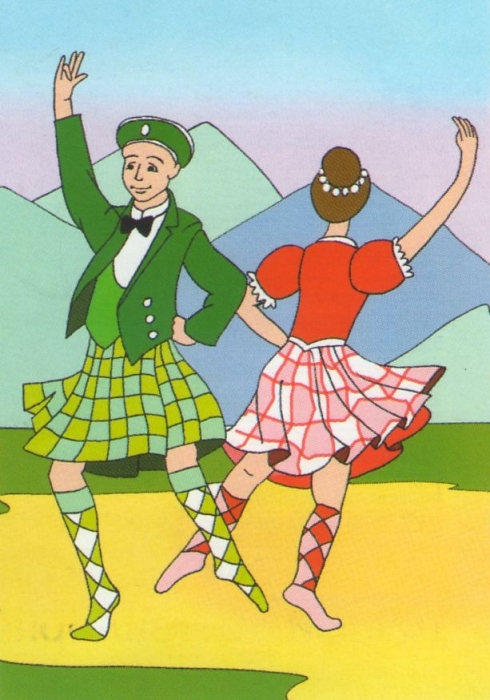 Charismatic gatherings are bright, emotional, often accompanied by rhythmic music.
Charismatic gatherings are bright, emotional, often accompanied by rhythmic music.
The most expansive personalities, subject to strong emotions, often feel at such meetings the desire to "reconnect with the divine power." This is expressed in attacks of causeless laughter (“divine laughter”), in involuntary twitching movements of the whole body and falling into hysteria.
In the Middle Ages, such a state of mind was by no means uncommon. Usually, young girls suffering from nervous disorders were subjected to seizures. They began to fall to the ground, roll on it, beat their heads and make sounds similar to a dog barking or a cock's cry (signs). However, this behavior turned out to be extremely contagious for others, and after a short time they were accompanied by much more mature people, and in large numbers.
When in Italy, people bitten by a tarantula began to experience exactly the same symptoms, the disease was called "tarantism", and the treatment that was prescribed for the unfortunate was the dance - tarantella. The patient had to jump and dance in one place, depicting how he tramples a spider. An interesting fact - the longer the "patient" danced, the more his chance of recovery increased. Subsequently, the tarantella was performed to prevent the disease, believing that in this way you can protect yourself from the bite of a dangerous insect.
The patient had to jump and dance in one place, depicting how he tramples a spider. An interesting fact - the longer the "patient" danced, the more his chance of recovery increased. Subsequently, the tarantella was performed to prevent the disease, believing that in this way you can protect yourself from the bite of a dangerous insect.
This was in the 15th century and continued until the end of the 19th century. A wave of tarantism swept across Europe. Modern doctors would easily recognize in the disease signs of a mental disorder - hysteria. However, in those early years, illness was almost a sacred act. Hysteria and mass psychosis carried the status of "the greatest spiritual awakening of Christianity."
Scientists who study the phenomenon of obsession with dancing declare that tarantism is nothing but some form of depravity of consciousness. Putting on the mask of "bitten by a tarantula", people began to dance frantically, making obscene gestures. At the time of the dance, all daily activities were abandoned, the dancers did not care about their relatives and friends, the children were left unattended by their mothers and fathers.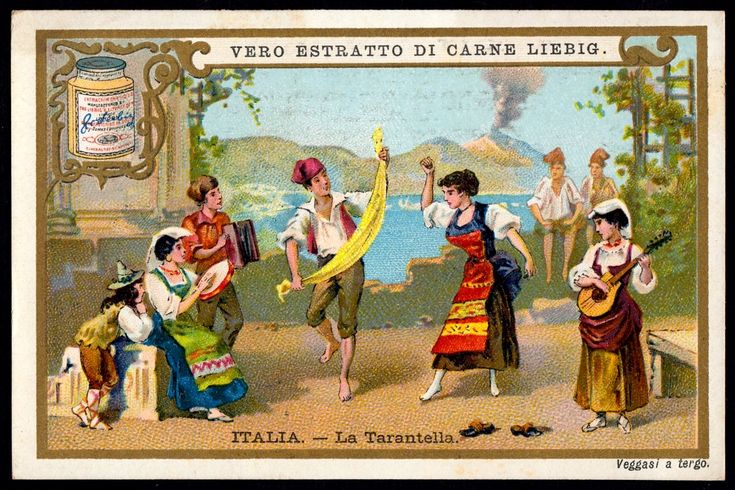
In a fit of madness
In addition to frenzied dancing, no less strange things happened to people: they swallowed small stones, pieces of broken glass and even burning coal. Women and men stood on their heads, assumed bizarre poses and convulsed. It was in France in the 18th century in the heart of Paris! The government, in order to stop mass abnormal phenomena, issued a decree banning such "", and everyone who tried to dance was put in jail. (from the book of Louis Figier - French naturalist, writer).
America has also experienced epidemics of mental disorders. The "Great American Renaissance" began in 1832 simultaneously in New York and New Haven. Men and women, gathered on the shores of Lake Ontario, listened to numerous preachers who proclaimed themselves "children of God" and called for cleansing from sin. How should the cleansing take place?
During a frantic dance, otherwise called the "dance of St. Vitus." Sinners, frantically making unthinkable body movements, felt like they were born again and began to look for "their Eden and their Eve. " Own houses and wives could not correspond to ideas about the highest goods, so there were searches on the side. Marital ties were torn, new ones were created, at first only spiritual heavenly unions.
" Own houses and wives could not correspond to ideas about the highest goods, so there were searches on the side. Marital ties were torn, new ones were created, at first only spiritual heavenly unions.
However, soon the spiritual unity was considered incomplete and the relationship eventually took on the character of a sexual relationship. Complete chaos began among people - other people's wives approached other people's husbands ... But, realizing that such relationships were erroneous, new unions broke up to be reborn with the third, fourth, fifth chosen ones. As the chroniclers note, "the doctrine of spirituality was destroyed by debauchery." (from Albert S. Rhodes).
Tarantella is the most famous Italian dance, which has become a real symbol of the country and the Italian nation.
This bright and lively dance is shrouded in age-old legends and myths, one way or another connected with poisonous tarantula spiders. Legend has it that in the 14th and 15th centuries, in the southern regions near the city of Taranto, tarantulas bred and bit women. Of course, only commoners who worked in the field were bitten. Under the influence of the poison of tarantulas, poor women fell ill with tarantism (tarantism is a medical term for one of the forms of hysterical behavior). There was talk of a real epidemic. A method of treating those who fell into a trance with the help of dance was proposed. Musicians surrounded the woman and played music at a fast pace, forcing the patient to dance. Sometimes this dance was called the spider dance.
Of course, only commoners who worked in the field were bitten. Under the influence of the poison of tarantulas, poor women fell ill with tarantism (tarantism is a medical term for one of the forms of hysterical behavior). There was talk of a real epidemic. A method of treating those who fell into a trance with the help of dance was proposed. Musicians surrounded the woman and played music at a fast pace, forcing the patient to dance. Sometimes this dance was called the spider dance.
One of the older legends says that the tarantella originated in the time of sacrifices, when a beauty sacrificed to spiders, making quick movements, tried to avoid bites.
There is also a version that in the old days, the consequences of a tarantula bite, of which there are plenty in southern Italy today, were eliminated with the help of profuse sweating. Dance until the seventh sweat and was tarantella. Wandering musicians were always ready to come to the aid of a bitten spider. Everyone who happened to be nearby hurried to help. So the dance became pair and group. Later, the tarantella was considered the personification of lust, because frantically dancing women have always attracted increased male attention.
So the dance became pair and group. Later, the tarantella was considered the personification of lust, because frantically dancing women have always attracted increased male attention.
The noble gentlemen also liked the Tarantella. In the 17th century, the tarantella began to be danced even at balls. By that time, the epidemic of tarantism had also ceased.
Tarantella music is always improvisation with great sound extensions and cadence additions. They perform tarantella on various musical instruments - mandolin, accordion, guitar, but always without fail to the accompaniment of tambourine and castanets.
Tarantella has become a classic. This dance can be seen in the theater and cinema, it has penetrated into literature and painting. We can safely say that the tarantella is part of the soul of a true Italian. Today the tarantella is ubiquitous in Italy, but is still more popular in the southern regions. No holiday is complete without this incendiary dance. In different regions of Italy, the tarantella has its own characteristics, and sometimes a special name.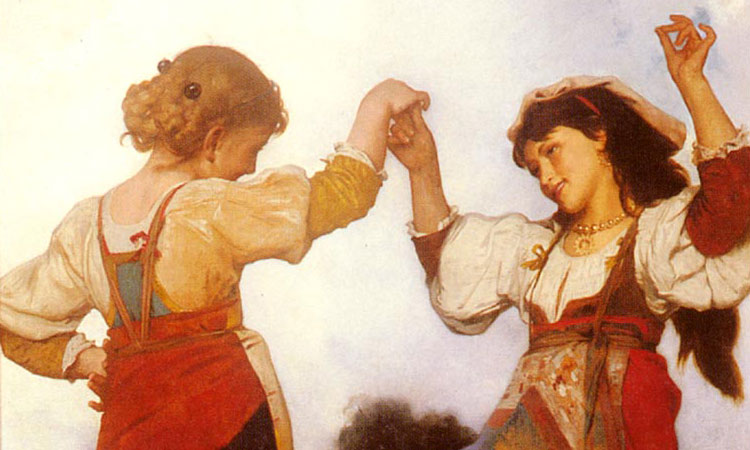 Tarantellas differ in different regions and in the degree of fury of the dance, in some places it can even look somewhat sedate.
Tarantellas differ in different regions and in the degree of fury of the dance, in some places it can even look somewhat sedate.
No one is complete without a tarantella!
Neapolitan Tarantella:
Neapolitan Tarantella on accordion:
Neapolitan Tarantella performed by the orchestra. Vocal Renzo Arbore:
Neapolitan Tarantella performed by Mario Lanza:
Neapolitan Tarantella Pulchinella:
Tarantella Apulya:
Tarantella Sicilian:
Tarantella Kalabria:
And this is for those who want to teach dance to Tarantella:
003
In August 2017 in Salento (south of the Puglia region, the heel of the Italian “boot”) the 20th anniversary festival “La Notte della Taranta” (“Night of the Tarantula”) takes place . This is one of the biggest Italian music festivals : it lasts two weeks, covers a couple of dozen settlements, and attracts the attention of hundreds of thousands of tourists. In this note, we will begin the story of tarantella, a genre of southern Italian folk song, whose fate is rather unusual. .
.
But first let's listen to the Apulian variety of tarantella (it's called pizzica ) from the final concert of "La Notte della Taranta" in 2011, performed by a whole orchestra and with a theatrical dance performance:
The word "tarantella" goes back to the name of the spider tarantula, which, in turn, is named after the place of its origin - the Apulian city of Taranto (ancient Tarentum) . The connection with the spider is not accidental: such music has been used for centuries as a medical ritual designed to cure the effects of a tarantula bite .
The first evidence of this disease and its treatment with music therapy dates back to the 13th century, and the last cases of the disease were recorded in the first half of the 20th century. Tarantism coverage area ( tarantismo ; patients were called tarantato/a or tarantolato/a ) includes southern Italy and the Mediterranean coast beyond 1) See, for example, .
It was believed that a poisonous spider bites people working in the field in summer - as a rule, women of reproductive age (we will talk about why this is so a little later) - and that the patient can "remove poison from the blood" with the help of dance . For this wali musicians who played rhythmic melodies, accompanying them with incantation verses. This could take several hours or even days. The dance had the character of a magical action: the patient imitated either the movements of the spider itself or the struggle with it. By the nature of the patient's behavior, they judged the "character" and even the color of the bitten spider, and depending on this, certain melodies were played: fast, melancholic, with a certain rhythm, etc.
Illustration for the 1627 edition of the New Testament. Shipwreck and miraculous rescue of St. Paul from the snake.
Starting from the 17th-18th centuries. the treatment of tarantism acquires a "divine patron" - St. Paul . A folk legend according to which St. Paul turns healer from bites of poisonous snakes and insects , based on an episode from the Acts of the Apostles (28.3-6). The ship on which Paul is being taken to the court of Caesar in Rome is shipwrecked off the coast of Malta, and there the apostle is miraculously saved from a poisonous snake that does not cause him any harm.
Paul . A folk legend according to which St. Paul turns healer from bites of poisonous snakes and insects , based on an episode from the Acts of the Apostles (28.3-6). The ship on which Paul is being taken to the court of Caesar in Rome is shipwrecked off the coast of Malta, and there the apostle is miraculously saved from a poisonous snake that does not cause him any harm.
Chapel of St. Paul in Galatina with a well inside. Fonte: tripadvisor.it
June 29, the day of the veneration of the apostle, in the chapel of St. Paul in the city of Galatina (according to local legend - one of the stops of Paul during his journey to Rome), crowds of patients and their relatives flocked. They drank water from the holy spring inside the chapel, danced and prayed for recovery.
In the texts of the tarantellas, there are frequent requests addressed to Paul:
E Santu Paulu miu de le tarante
famme na grazia a mie e a tutte quante.
Do a good deed for me and everyone else.
Santu Paulu meu de Galatina,
Facitece ‘na grazia, ‘sta mattina.
Saint Paul from Galatina,
Do a good deed this morning.
True, sometimes these texts can be confusing:
E Santu Paulu miu de le tarante,
Pizzichi le caruse tutte quante.
Saint Paul, (patron saint) of spiders,
You bite girls all over the place.
Santu Paulu meu de le tarante,
pizzichi le caruse a 'mmenzu ll'anche.
Saint Paul (patron saint) of spiders,
That stings the girls between the legs.
These examples show that Saint Paul in the southern Italian folk-Christian tradition was perceived as a trickster - a supernatural being who is completely "responsible" for the disease - that is, he can both send it and cure it 2) See Madonnas That Maim: Popular Catholicism in Italy Since the Fifteenth Century
Contributors: Michael P.
 1.
1. 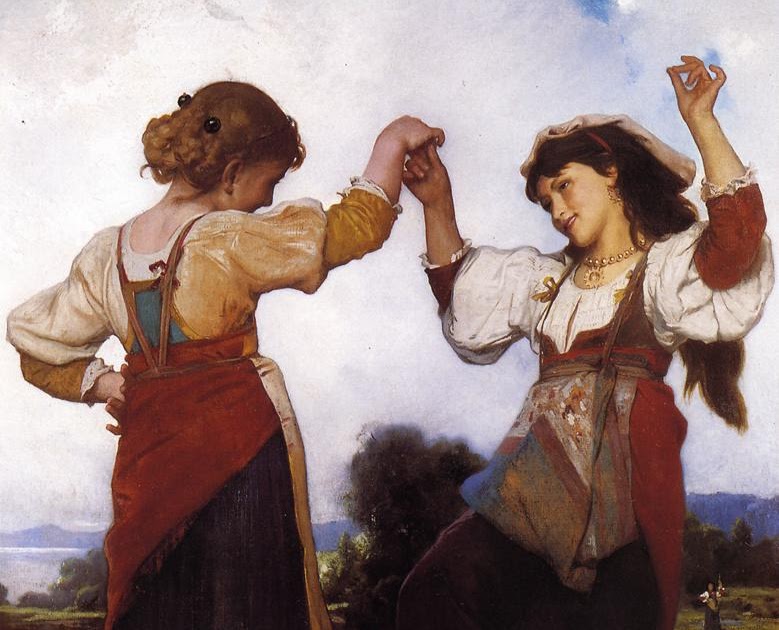 Eight Measures.
Eight Measures.  Right arm extended in front and left arm extended to the rear at the height of the shoulders. Stop abruptly–pause an instant–take hands–and run off . . . . . . Six Measures.
Right arm extended in front and left arm extended to the rear at the height of the shoulders. Stop abruptly–pause an instant–take hands–and run off . . . . . . Six Measures. 










